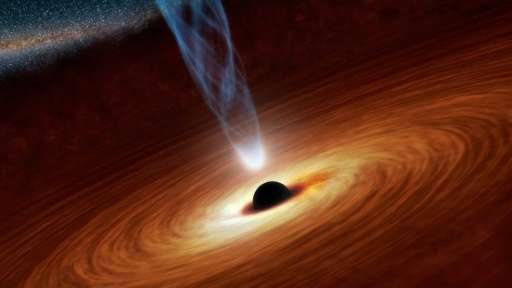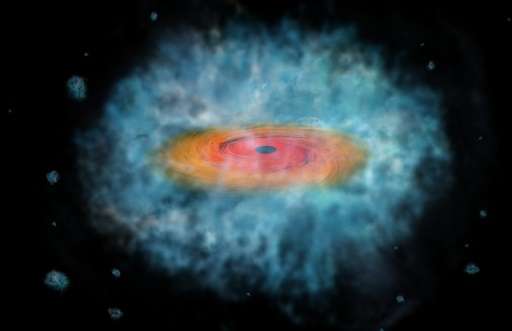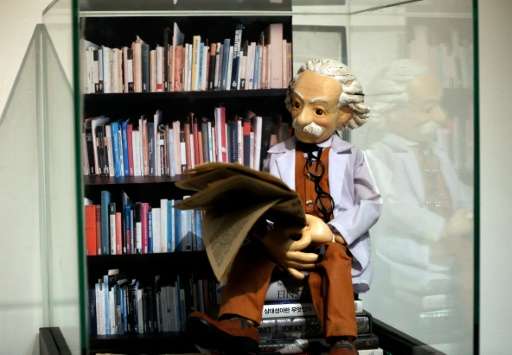Desert telescope stakes out supermassive black hole

First postulated more than 230 years ago, black holes have been extensively researched, frequently depicted, even featured in sci-fi films.
We've all seen the artists' impressions and read of their ravenous star-gobbling feasts.
But here's the thing... science is still not 100 percent sure what they look like, how they behave or even that they exist.
Telescopes have never seen a black hole, and the world's brightest minds are unable to reconcile their core characteristics with some of the bedrock laws of nature.
Seeking answers, scientists have trained a massive telescope, named Gravity, in Chile on a point some 24,000 light years away where a supermassive black hole is thought to lurk at the centre of our Milky Way galaxy.
The enormous eye will look for miniscule but telltale deviations in the movement of gas and stars swirling around the monster hole.
"The goal of Gravity is to finally prove the existence of a black hole at the centre of our galaxy," project member Guy Perrin, an astronomer from the Paris Observatory, told AFP.
But finding something unexpected would in some ways be an even bigger breakthrough as it may offer clues to our imperfect understanding of physics.
Sharper than ever
Gravity's theorised target, Sagittarius A, is four million times more massive than our Sun, packed into an area smaller than the Solar System.
To observe it up close, astronomers have combined the power of Europe's four largest telescopes, based in the Atacama desert, to create the most powerful instrument of its kind ever built.

The images will be "about 10-20 times sharper than what we had before," said project leader Frank Eisenhauer of the Max Planck Institute for Extraterrestrial Physics.
With a combined diameter of about 130 metres (427 feet), the device will allow astronomers to observe more detail, closer to the black hole, than ever before.
"We will check whether our physical understanding is correct to conclude it is a black hole," Eisenhauer told AFP by telephone from Atacama, where the telescope is being put through its paces before starting full-scale observations, probably next year.
"If you see the motion of matter so close to a black hole, it would be very difficult to find any other explanation."
Black holes are regions in space-time where mass is collapsed into such a small area that gravity takes over completely, and nothing can escape its pull.
Eighteenth century amateur clergyman and scientist John Michell is credited with conceptualising black holes in 1783.
They were also predicted in Albert Einstein's theory of general relativity, published in 1915.
There are two types: "stellar mass" black holes that form when a monster star implodes, and the "supermassive" variety which lie at the centre of large galaxies.
Ubiquitous as they are believed to be—millions in the Milky Way galaxy alone—black holes are invisible because they absorb light, along with everything else.
Was Einstein wrong?
Their existence is inferred from the behaviour of objects nearby, including stars swirling around them as planets orbit our Sun.

Some scientists, including physicist Stephen Hawking, have suggested black holes—if they exist at all—may not fit the general relativity mould.
In February, evidence for stellar mass black holes emerged when scientists observed a gravitational wave—a ripple theorised to move through space-time when two of these beasts collide.
Each black hole, in Einstein's world, should have an "event horizon," a point of no return beyond which gravity takes over.
But a major problem in science today is that general relativity does not gel with quantum mechanics, the other pillar of modern physics.
Quantum physics perfectly describes phenomena on the minuscule, subatomic level, but gravity does not seem to work on that scale.
When it comes to black holes, general relativity predicts that nothing can escape them. Quantum theory, however, posits that no information from the Universe can ever just disappear.
By zooming in so close on the event horizon, "we will be able to test a number of theories in an environment with an extreme gravitational field," said Karine Perraut of the Grenoble Observatory in southeast France.
It will be the toughest test yet for general relativity, which has withstood all other science challenges.
For Einstein to be right, the Gravity team would have to see the stars' orbit change slightly with every full rotation around the black hole.
But what it would look like if Einstein was wrong, nobody knows.
"I can only imagine the shock if we cannot confirm that it is a black hole. It will have huge implications for our understanding of the Universe!" said Perrin.
Gravity started early operations in June and is expected to report on progress next week.
© 2016 AFP



















